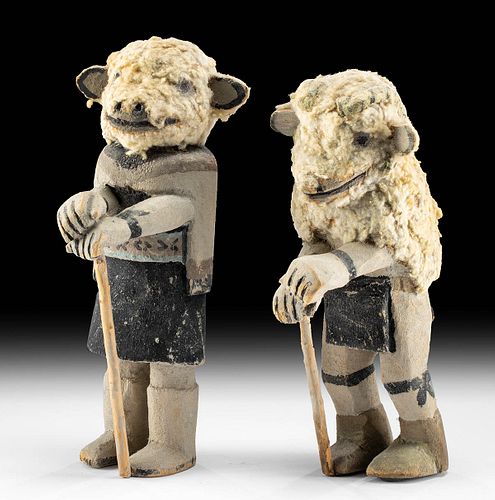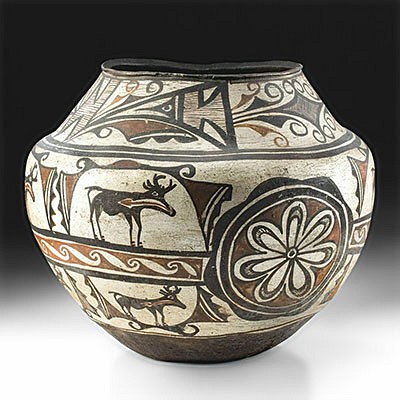Important 20th C. Hopi Sheep Kachinas, Jimmy Koots
Lot 4
About Seller
Artemis Fine Arts
686 S Taylor Ave, Ste 106
Louisville, CO 80027
United States
Selling antiquities, ancient and ethnographic art online since 1993, Artemis Gallery specializes in Classical Antiquities (Egyptian, Greek, Roman, Near Eastern), Asian, Pre-Columbian, African / Tribal / Oceanographic art. Our extensive inventory includes pottery, stone, metal, wood, glass and textil...Read more
Estimate:
$7,500 - $11,250
Absentee vs Live bid
Two ways to bid:
- Leave a max absentee bid and the platform will bid on your behalf up to your maximum bid during the live auction.
- Bid live during the auction and your bids will be submitted real-time to the auctioneer.
Bid Increments
| Price | Bid Increment |
|---|---|
| $0 | $25 |
| $300 | $50 |
| $1,000 | $100 |
| $2,000 | $250 |
| $5,000 | $500 |
| $10,000 | $1,000 |
| $20,000 | $2,500 |
| $50,000 | $5,000 |
| $100,000 | $10,000 |
| $200,000 | $20,000 |
About Auction
By Artemis Fine Arts
Nov 18, 2021
Set Reminder
2021-11-18 10:00:00
2021-11-18 10:00:00
America/New_York
Bidsquare
Bidsquare : Art & Artifacts of North America
https://www.bidsquare.com/auctions/artemis-gallery/art-artifacts-of-north-america-7894
Join us for a special auction not to be missed! Collectible Native American art from antiquity to mid-20th century, Spanish Colonial, Latin American, Pre-Columbian, fine & folk art, American frontier items, fossils, and much more! Artemis Fine Arts info@artemisfinearts.com
Join us for a special auction not to be missed! Collectible Native American art from antiquity to mid-20th century, Spanish Colonial, Latin American, Pre-Columbian, fine & folk art, American frontier items, fossils, and much more! Artemis Fine Arts info@artemisfinearts.com
- Lot Description
Attributed to Jimmy Koots also known as James Kootshongsie (Native American, Hopi Pueblo, 1916 to 1996) ca. mid to late 20th century CE. A pair of handmade kachina dolls carved from wood with sheep fleece adorning the heads of these figures that represent human dancers dressed as the sheep kachina, Pang. They are carved in the traditional style, likely using cottonwood, and painted in gray and black pigments. Pang is believed to have the power to cure ills and bring rain and typically dances with a cane. Both kachina stand upright - one is slightly stooped forward - and hold dancing canes before them. The male or ram kachina wears a loin cloth and has horns that curl behind his perked ears. The female kachina has a knee length skirt and shawl. The woolen fibers are adhered to the wood from the neck up on the female, and down the back of the male like a cape. Kachina dolls are made in the likeness of the dancers that portray the spirits and used as teaching tools for children. Size: 2.75" W x 9" H (7 cm x 22.9 cm)
James Kootshongsie, better known as Jimmy Koots, is a famous Hopi carver, accredited with reviving the Kachina carving tradition. Koots was taken from Hotevilla Arizona at a young age and placed in a government run school. He spent five years in a climate hostile to Hopi beliefs and heritage. Once he returned to his hometown, he was once again whisked away into WWII. Returning to Arizona, he became an activist in the fight to keep oil and gas companies from strip mining the Hopi ancestral land. His carvings revived the traditional styles of Hopi Kachinas. Most of his carvings are unsigned but are distinctive and indicative of Koots’ style. For more information on the genius of Jimmie Koots please refer to the book "The Great Tradition of Hopi Katsina Carvers: 1880 to Present" by Barry Walsh
The Katsinam, supernatural beings who live in the high mountains of the San Francisco Peaks above traditional Hopi territory, speak to the Hopi through costumed dance and song. These dancers emerge from the round ceremonial kivas that are at the center of their communities, singly or in groups, and dance to the music of drums, rattles, and song. Katsina figures (katsina dolls, katsin-tihu), are made of cottonwood root to represent these supernatural beings. Cottonwood is culturally symbolic because the cottonwood tree, once abundant in traditional Hopi lands, grows where water flows - thus, looking across a landscape, lines of cottonwood trees denote a water source in the desert. After carving, the figures are painted all over with whitewash, made from kaolin clay, and then painted in brilliant colors. Originally these were done using yucca brushes. Many katsina are then decorated with other materials, like feathers, cloth, or fur, like these wool sheep! Katsina dolls are often given objects to hold which indicate their roles. Before the European introduction of domesticated species, the wild big horn sheep were the only sheep throughout western North America. The majestic rams were symbolic of strength and virility, protecting the flock from harm.
Provenance: ex-William and Jane Frazer, Aspen, Colorado, USA, acquired 1980s
All items legal to buy/sell under U.S. Statute covering cultural patrimony Code 2600, CHAPTER 14, and are guaranteed to be as described or your money back.
A Certificate of Authenticity will accompany all winning bids.
PLEASE NOTE: Due to recent increases of shipments being seized by Australian & German customs (even for items with pre-UNESCO provenance), we will no longer ship most antiquities and ancient Chinese art to Australia & Germany. For categories of items that are acceptable to ship to Australia or Germany, please contact us directly or work with your local customs brokerage firm.
Display stands not described as included/custom in the item description are for photography purposes only and will not be included with the item upon shipping.
#166635Purposefully distressed and weathered. Chips to ears and other high pointed areas. Fading of pigments. Pilling and minor shedding to wool. Faint initials or date on foot of one kachina that is difficult to discern. Rare depictions.Condition
- Shipping Info
-
All shipping is handled in-house for your convenience. Your invoice from Artemis Gallery will include shipping calculation instructions. If in doubt, please inquire BEFORE bidding for estimated shipping costs for individual items.
-
- Buyer's Premium



 EUR
EUR CAD
CAD AUD
AUD GBP
GBP MXN
MXN HKD
HKD CNY
CNY MYR
MYR SEK
SEK SGD
SGD CHF
CHF THB
THB














